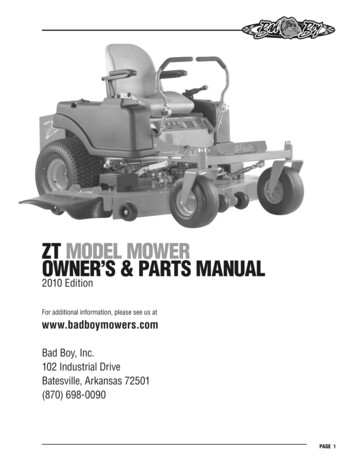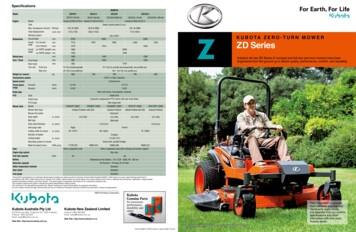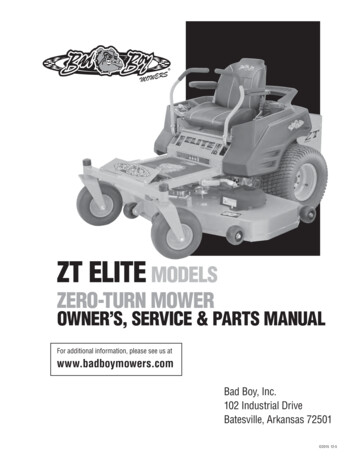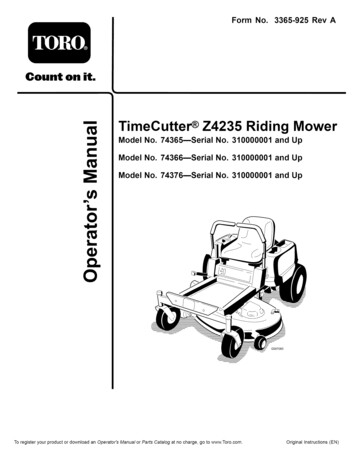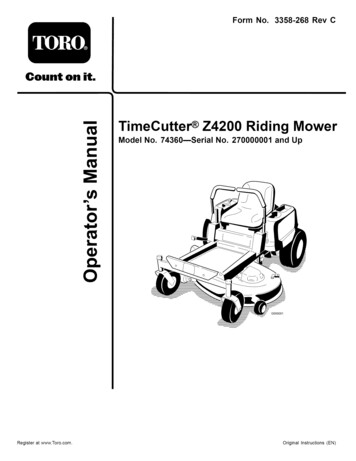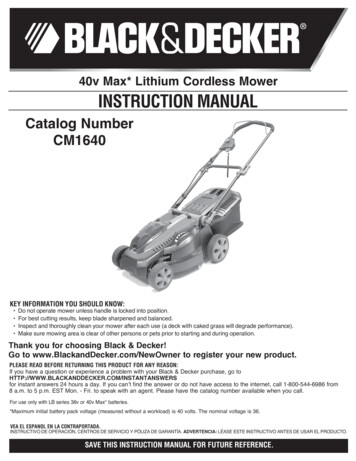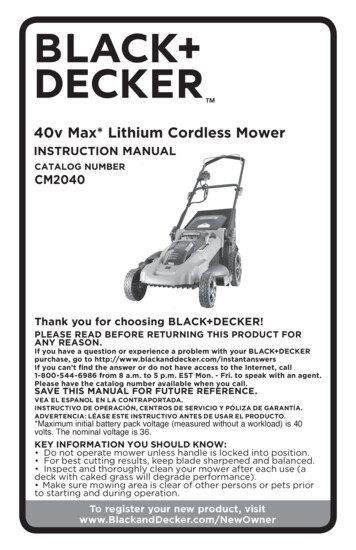
Transcription
Lightning& PupZERO-TURN MOWEROWNER’S, SERVICE & PARTS MANUALFor additional information, please see us atwww.badboymowers.comBad Boy, Inc.102 Industrial DriveBatesville, Arkansas 72501(870) 698-0090
TABLE OF CONTENTSBasic Information. Section 1 (pages 4–5)Bad Boy Safety Guidelines. Section 2 (pages 5–6)Operation. Section 3 (pages 6–7)Maintenance. Section 4 (page 7)Storage and Transportation. Section 5 (page 8)Troubleshooting and FAQ. Section 6 (pages 8–9)Controls. Section 7 (page 9)Moving Inoperable Mower. Section 8 (page 10)Instrumentation. Section 9 (page 10)Mower Blade Maintenance.Section 10 (page 11)Greasing Bearings. Section 11 (pages 11)How to choose the right blade.Page 12Mowing Tips. Page 21SERVICE SECTION BEGINS ON PAGE 13PARTS SECTION BEGINS ON PAGE 22LIMITED WARRANTY PAGE 50PAGE 2
This manual applies to the following equipment:Bad Boy Lightning and Pup SeriesLightning 5200 52 26hp Kawasaki LCLightning 6000 60 26hp Kawasaki LCLightning/Pup 5200 52 30hp KohlerLightning/Pup 6000 60 30hp KohlerLightning 6000 60 31hp KawasakiLightning 7200 72 31hp KawasakiLightning 6000 60 32hp VanguardLightning 7200 72 32hp VanguardCOMMONLY USED ITEMS AND PART NUMBERS72 BladeHi-Lift Fusion038-7230-0060 BladeHi-Lift Fusion038-6060-0052 BladeHi-Lift Fusion038-0001-00Deck Belt72 041-1890-00Pump Belt041-5048-00Vanguard 32hpOil Filter063-8018-00Air Filter Inner063-8020-00Air Filter Outer063-8019-00Kawasaki 31hpOil Filter063-8017-00Air Filter Inner063-2031-00Air Filter Outer063-2032-00Kohler 30hpOil Filter063-5400-00Air Filter Inner063-8020-00Air Filter Outer063-8019-00Kawasaki 26hpOil Filter063-2090-00Air Filter Inner063-8020-00Air Filter Outer063-8019-00Motor Oil10w30 (2 quarts)Hydro Oil20w50 (8 quarts)Gator Blade038-5400-00Gator Blade038-6003-00Gator Blade038-0003-0060 041-1650-00Wave Blade038-7215-00Wave Blade038-6015-00Wave Blade038-5220-0052 041-1490-00PAGE 3
SECTION 1: BASIC INFORMATIONCongratulations on the purchase of your new Bad Boy Mower! The purpose of this manual is to assistoperators in maintaining and operating their machine. The information and instructions in this manual canhelp you attain years of performance from your new Bad Boy. Also, check out our website to learn moreabout the Bad Boy family.1.11.21.31.41.5All Bad Boy engines use 10W30 engine oil. Conventional or Synthetic may be used.All Bad Boy hydraulic systems use 20W50 engine oil. Conventional or Synthetic may be used.All Bad Boy Mowers use hi-temp multi-purpose grease. NLGI No. 2 for the grease fittings.Lightning/Pup models have 12 psi in both front and rear tires.Most Briggs, Kohler, Kawasaki, and Vanguard engines hold two (2) quarts of motor oil.Warranty RegistrationThe Warranty Registration form must be completed and signed to validate your warranty. As the newequipment owner, you are expected to see that the form is completed and forwarded to Bad Boy, Inc.,at time of delivery. Warranty is non transferable.Model/Serial NumberYour Lightning/Pup model serial numbers are found on the SIN plate underneath seat. The serial numbersare necessary on the warranty registration form. Also, these numbers can assist you in the ordering ofnew parts when replacements become necessary.Parts/ServiceOnly Bad Boy replacement parts are to be used on your mower.Replacement parts are available through your local Bad Boy Mower Dealer. Remember to always providethe following information when ordering parts:1. Correct part number2. Correct serial numberAll warranty repair and service must be handled through your authorized Bad Boy Mowers dealer.To locate the nearest dealer, go to our website and click on Locate a Dealer.PAGE 4
SECTION 2: MOWER SAFETY GUIDELINESNever allow untrained people to operate this machine. It is the owner’s responsibility to get training andsee to it that anyone who has permission to use your machine receives the proper training.Do not mow around people. The factory discharge chute is designed to deflect debris downward, but itcould be possible for debris to be thrown in a way that can cause damage to people or property.Seek additional training when possible to learn more about safety techniques and practices.Safety Precautions2.2Always remain seated while operating machine.2.3Always maintain a safe distance from people and pets while mowing.2.4Always disengage blades, place steering controls in neutral, engage parking brake, and removeignition key when leaving operators seat.2.5Always operate machine in daylight or with adequate working lights.2.6Be alert of surroundings. Watch for rocks, stumps, and mounds or depressions while mowing.2.7Always wear eye protection while mowing and servicing.2.8Always wear ear protection, such as earplugs, while mowing.2.9If you strike something with the mower turn the blades and mower off, engage the parkingbrake, and inspect the machine for damage before resuming.2.10 Be aware of low hanging limbs or objects that could potentially be hazardous while mowing.2.11 Never operate a poorly maintained machine.2.12 Never carry passengers.2.13 Always buckle seat belt, if provided one.2.14 Never attempt high speed maneuvering, especially around people or property.2.15 Never put hands or feet under the machine while ignition is on.2.16 Never refuel machine when engine is running.2.17 Never leave key in ignition, especially around children.2.18 Never run engine in enclosed area.2.19 Do not touch hot parts of machine.2.20 Do not remove deck wheels.2.21 Conditions that can affect traction resulting in the loss of control of machine: Wet terrain, Hillsor extreme angles, Depressions in the ground, Mounds of dirt, Extremely dry grass, Soil type(gravel, sand, clay), Tire pressure2.22 Be aware of what is located at the bottom of slopes. For example, Rocks, Water, Cliffs, Roadsand HighwaysPAGE 5
2.23 Safety warning decals are located on the mower and should always be observed and followed.2.24 Never operate the mower with the discharge chute open.2.25 Prevent Fires—Remove grass and debris from engine compartment and muffler area, beforeand after operating machine, especially after mowing or mulching in dry conditions.2.26 Do not store machine near open flame or source of ignition, such as a water heater orfurnace.2.27 Do not attempt to mount a tire without the proper equipment and experience to perform thejob.2.28 Always maintain the correct tire pressure. Do not inflate the tires above the recommendedpressure. Never weld or heat a wheel and tire assembly. The heat can cause an increase in airpressure resulting in a tire explosion. Welding can structurally weaken or deform the wheel.2.29 Never operate machine in a closed area where dangerous carbon monoxide fumes can collect.2.30 Let engine cool before storing!!!2.31 Hydraulic hoses and lines can fail due to physical damage, kinks, age, and exposure. Checkhoses and lines regularly. Replace damaged hoses and lines.2.32 Park machine on level ground. Never allow untrained personnel to service machine.Understand service procedure before doing work.SECTION 3: MOWER OPERATIONNever operate the machine with faulty equipment. Always be alert of sudden changesin landscape, as the mower will react differently on slopes or embankments than it willon flat surfaces. Never operate the mower with the discharge chute open. Do not crossterrain, other than grass, with blades turning. This could cause damage to property orbystanders.PAGE 63.1Place parking brake in up position3.2Drive arms must be in the “open position. While sitting on the machine, each arm ispositioned away from the operator, to the right and left. Drive arms will lock into place andmust be in this position to start machine.3.3Put PTO switch in the OFF position.3.4If your machine has been equipped with a ROPS (Roll Over Protection System) then youmust fasten seatbelt.3.5If machine has not been started recently, engage the choke.3.6Make sure nothing is under or around machine.3.7Place key in ignition and turn.3.8Once machine is started, disengage the choke.
3.9Increase RPM by sliding the throttle to fast position, toward the rabbit.3.10 Owners must become familiar with the controls before operating a zero-turn radius vehicle.3.11 Start slowly and build your skill level. Have ample practice before using the machine at fullcapabilities.3.12 Be comfortable with machine before engaging blades. Know what each component controlsbefore using machine.3.13 Your mower will perform differently on an incline /decline. Be cautious, slow down, and donot make any sudden jerking movements with control arms. The machine could lose tractionon a decline or tip backwards on an incline.3.14 Once you become comfortable with your Bad Boy Mower you will notice your overall mowingtime will decrease.Avoid operating your mower on side hills of over 5 degrees, inclines of over 10 degrees,and declines of over 15 degrees.SECTION 4: MOWER MAINTENANCE**Check each and provide maintenance when needed.DAILY4.1Check Engine Oil4.2Check Engine Air Filter4.3Tire Pressure4.4Inspect BladesWithin FIRST five hours of usage, change engine oil and filterEVERY 30 HOURS OF USAGE4.5Grease MachineEVERY 50 HOURS OF USAGE4.6Change Engine Oil and FiltersCheck filters once a year if under 50 hoursCheck air and fuel filters more often in dry, dusty conditionsWithin FIRST 50 hours of usage, change hydraulic oil and filtersEVERY 250 HOURS OF USAGE4.7Change Hydraulic Fluid and Filters4.8Refer to manufacturer manual for specific information on maintenance schedules.PAGE 7
SECTION 5: MOWER STORAGE & TRANSPORTATION5.1Keep machine from collecting debris by storing in a covered area while not in use.5.2Fuel can harm your machine if left for more than 30 days without changing, especially if thefuel contains ethanol. Never use fuel with more than 10% ethanol by volume. E-15 is notpermitted.5.3Disconnect the negative battery cable when machine will be stored for more than 30 days.5.4Always secure machine properly when transporting machine.5.5Do not load machine on trailer with blades engaged.5.6Do not use ramps to load the machine.5.7Make sure Parking Brake is in “up” position.5.8In wet conditions tires may spin while loading / unloading. If necessary, wait for dryconditions before loading / unloading.5.9Make sure mode of transportation is suitable to bear the weight of mower.5.10 Deck height should be set at maximum before attempting to load.5.11 Secure mower with at least two straps capable of securing weight of mower.SECTION 6: TROUBLESHOOTINGPAGE 86.16.1Q: How do I prevent an uneven cutting pattern and increase the quality of cut?A: Check tire pressure, check blade sharpness (replace blades or sharpen at least onceper year or when needed), make sure blades are tightened properly, check spring and belttension, check the underside of the deck to ensure the mower deck is free of grass build-upand debris, make sure your machine is at full throttle, and vary your mowing pattern eachtime you cut your grass.6.26.2Q: What should I do if my mower won’t start?A: Check battery charge and connection (grounds), check your fuel (make sure fuel is lessthan 30 days old and contains no water), make sure your spark plug is in good conditionand spark plug wire is attached, and make sure air filter is clean (a dirty filter makes it moredifficult for the engine to draw air). Check for broken wires or bad connections.6.36.3Q: What should I do if the blades won’t engage?A: Make sure the safety switch is plugged in on the bottom of seat. Check the underside ofthe PTO engager to ensure the plug is secure at switch.6.46.4Q: What type of fuel is recommended for my mower?A: We recommend that you use a name brand fuel to ensure quality. Use fuel with an octanerating near 87. Higher octane fuels offer no benefit. Only fuels with an ethanol content of10% or less may be used. E-15 is not permitted.
6.56.5Q: Do you offer touch-up paint for your mowers?A: Touch-up paint is available. Contact your local dealer for more information.6.66.6Q: How durable is the electric deck lift?A: The actuator which controls the deck height is designed for moving loads of up to 1000pounds and has a static holding capability which exceeds 3,000 pounds. Our ¼ deck weighsapproximately 250 pounds which is only 25% of working capability.SECTION 7: CONTROLS7.1Ignition Switch—Bad Boy Mowers have a three position ignition switch: off, run, and start.With key inserted, rotate it clockwise to START position and release key when engine starts,and switch will automatically return to he RUN position.7.2Throttle Control—A cable is connected to the engine throttle for controlling engine speed.Move lever forward to increase engine rpm, move lever backward to decrease engine rpm.7.3Choke Control—A cable is linked to manually operate the engine choke. When the lever isin the down position, the choke is in the off (run) position. When the lever is pulled up, thechoke is in the on (start) position. Do not operate the machine in the on (start) position. Thechoke lever is behind the throttle control.7.4Control Levers—These levers control the mower’s speed, direction, and neutral lock. Theselevers are used to steer, accelerate, decelerate and change direction. (Drive Arms)7.5Blade Engage Switch—This switch engages the blades. Pull the switch up to engage theblades and push the switch down to disengage the blades.7.6Deck Lift Control—The deck lift switch is used to raise and lower the deck. Pull the switchbackwards to raise the deck and push the switch forward to lower the deck.7.47.27.37.57.67.1PAGE 9
SECTION 8: Moving Inoperable Mower8.1Do not tow machine. Use a winch to load on a trailer for transporting.8.2 ATTENTION: RETURN BYPASS VALVES TO OPERATING POSITION BEFORE RUNNINGMOWER FOLLOWING REPAIRS.8.3Lightning/Pup Models are equipped with two neutral engage/disengage arms, located atthe rear of the mower protruding from the frame and under the muffler. By pulling the armsout the mower can be put in a neutral position. Return the arms to the “forward position fornormal operation.8.4Your Bad Boy Mower Weighs:Lightning/Pup SERIES:1180—1310 lbs*** Weights fluctuate with the addition of accessories.8.5As you can see by the weights of the machines, you shouldn’t ever try to push or pull a BadBoy Mower by hand. This could cause serious bodily injury.8.6Hopefully, you’ll never need to use this section of the manual. However, if you do, useextreme caution when moving machine!SECTION 9: INSTRUMENTATION9 .1 Electronic Hour Meter—Registers Hour increments up to 9,999.9 total hours. This meterrecords the cumulative time the engine is running.PAGE 10
SECTION 10: MOWER BLADE MAINTENANCE10.1 Check mower blades after each use. This is essential for maintaining well-groomed turf. Keepthe blades sharp. If a dull blade is used for cutting, the grass will tear rather than cut. Thiscould damage the grass leaving a brown frayed top on the grass within a few hours. A dullblade will also require more power from the engine.10.2 NEVER attempt to straighten a bent blade by heating. NEVER attempt to weld a crackedblade. The blades can break and cause serious injury or death.10.3 NEVER work with blades while engine is running or deck clutch is engaged.10.4 ALWAYS place deck clutch in DISENGAGE position while performing maintenance.10.5 Use blocks when you MUST work under mower.10.6 ALWAYS wear thick gloves when handling blades.10.7 ALWAYS check for blade damage if mower strikes rock, branch, or other objects that couldpotentially damage the blade. (REMEMBER: NEVER CHECK BLADE WHILE ENGINE IS ON!NEVER CHECK BLADES WHILE BLADES ARE ENGAGED!)SECTION 11: GREASING THE BEARINGS11.1 Park the machine on a level surface and disengage the blade control switch.11.2 Move the motion control levers outward to the neutral position, engage parking brake, stopthe engine, remove the key, and wait for all moving parts to stop before leaving the operatingposition.11.3 Grease Type: NLGI grade #2 multi-purpose gun grease. Grease the front cater pivots.11.4 Clean the grease fittings with a cloth. Scrape any paint off the front of the fitting(s).11.5 Connect a grease gun to each fitting. Pump grease in fittings until greases begins to seep outof the bearings. Wipe up excess grease.11.6 Refer to service manual section for grease fitting locations.PAGE 11
HOW TO CHOOSE THE RIGHT BLADEEssentially there are only TWO basic styles of mowing blades used or approved for use on our currentproducts:1) The standard style of mowing blade is essentially designed for cutting grass and effectively dischargingthe clippings out from the deck to fall onto the lawn or to be captured in a grass collection system.Standard blades are also referred to as “2-in-1” (discharging & bagging ) or “high-lift” blades (becausethey are designed to create a higher-lifting airflow).2) Mulching blades generally have a more curved style surface and frequently include extra cuttingsurfaces along the blade edges. These blades may also come in a “ ” design (which is actually twoindividual blades arranged in a perpendicular fashion to enhance mulching). The “ ” blades are usuallyfound on older style mowers; newer ones utilize blades with more advanced mulching technology.Mulching blades may also be referred to as “3-in-1” (mulching, discharging & bagging) or “all-purpose”blades.Bear in mind that the re-circulating airflow design of 3/1 blades makes them less efficient at discharginggrass clippings than a standard 2/1 blade. As with most all-purpose tools, there is some give and take asopposed to using a tool designed for a more specific purpose.If you’re experiencing less-than-desired cutting or discharging performance with a 3/1 blade, you may wantto check into using a 2/1 blade. Conversely, if you’re using a 2/1 blade and want to mulch clippings, youshould see about the availability of mulching blades or a mulching kit.*The type of blade installed on a new mower is a decision the retailer makes for each model of mower, basedon the expected needs of most customers. If you’re unsure of which blade is on a particular model, inspectthe blade. Blades have part numbers stamped into them. Then compare these part numbers with the unit’sOperator’s Manual or Parts List.It is true there are many other styles of blades available. But since we don’t manufacture or recommendusing these other aftermarket styles, we will leave them out of this discussion. Should you want moreinformation on special application or aftermarket blades, you should contact the companies that make theseproducts. NOTE: Customers using non-OEM blades do so at their own risk. The use of unapproved (nonOEM) blades may void any or all of the mower and engine factory warranties.* MULCHING KITS – These generally consist of mulching blades and a mulching plug (which closes offthe discharge opening to keep the clippings contained under the deck for re-cutting) plus any necessaryhardware for installation. Please check with your parts distributor regarding the contents of a particularmulching kit.PAGE 12
SERVICE SECTIONSECTION 1: HYDROSTATIC SYSTEMTo change hydro oil on Pup, Lightning, AOS, and Dieselmodels, remove oil return lines from top of hydro tankand place them in a disposable oil container. Start and runmower until oil level is reduced down to about 2” of oilremaining in the tank. Do not allow air to enter the oil linesin the bottom of the tank. Keep in mind that only about75% of the hydro oil can be changed at a time. Use only20w50 motor oil in the hydro system. (Conventional orsynthetic oil may be used) Bad Boy recommends that thehydro oil and filters be changed within the first 50 hoursof usage and every 500 hours thereafter or once a year.(Pup, Lightning, AOS, and Diesel Models)Change hydro oil filters by unscrewing them from thefilter head. Fill new filters with 20w50 motor oil beforeinstalling. Use only Bad Boy replacement filters. Using anyother filter will result in damage to the hydro system andvoid the warranty.Once the system is refilled with oil, lift rear of mower untiltires are off the ground. Start engine, release parkingbrake, stay clear of moving rear tires, loosen bypass bolt½ to ¾ turns, move drive arms forward and backward 4 to6 times slowly. This will purge the air from the system.(the bypass bolt has a hole drilled through the side of thebolt head). This valve also serves as a neutral for movingthe mower without the engine running.PAGE 13
SECTION 2: DRIVE BELTShown above is a typical pump belt tesioner for Pup andLightning models.Factory setting is about .030” (about the thickness of acredit card) between coils as shown.Shown to the right is a typical pump belt layout for mostmodels.SECTION 3: ENGINEShown right is a Kawasaki engine with the “quick drain”oil drain located on the left side of the engine. Use a flatscrew driver as shown to loosen the drain. (Not availableon all models)PAGE 14
Most models have a drain hose installed on the engine,for easier oil changes. All gas engines used by Bad Boyuse 10w30 and have an oil capacity of 2 quarts. Bad Boyrecommends that the oil and filter be changed every 50hours of usage.The fuel filter is located in the fuel line about 12” from thecarburetor on the side of the engine. Note the direction offlow on the side of the filter. Replace once a year.Most all models have a vacuum operated fuel pumpbolted to the side or top of the engine. The pump has a“fuel in”, a “fuel out”, and a vacuum line coming from theengine block. Fuel flow can be checked here if the pump issuspected to be defective.Remove and inspect air cleaner weekly. (More often industy conditions). Do not blow filter out with air pressure,this will cause the filter to be filled with tiny holes thatwill allow dirt to enter. Instead, tap filter on side to removeany debris. Replace at least once a year, more often industy conditions.Torque the clutch bolt to 50 ft. Lbs. on all models.Retorque at every oil change. (All Models)Keep radiator screen clean and free of debris onliquid cooled models. Check screen hourly during dryconditions. Slide radiator screen up to remove.PAGE 15
SECTION 4: ELECTRICAL SYSTEMOn most larger commercial engines (27 hp and up), the25 amp main fuse is located about 3” from the starter onthe engine. (shown in first image on right). On smallercommercial and light duty commercial mowers, the 25amp main fuse is located just behind the battery connectedto the starter solenoid. (Shown in second image on right).Always check the condition of the wiring harness groundcable. The ground is located just inside of the right sidefuel tank on most models. Ensure that the ground isconnected, clean, and tight. On some models, this wiremay be connected to the negative side of the battery.Check the condition and connection of the relays locatedunder the seat. Ensure that they are clean and connected.Make sure that wire terminal ends have not been pushedout of the relay block.On most models, the red wire coming out of the engine isthe charging wire from the alternator. Check for 13.6—14.2volts DC at this wire with engine at full throttle.PAGE 16
PAGE 17
SECTION 5: FRAMEFor non-suspension models, torque front fork castle nut to40 ft.lbs. Be sure to spin the fork while torquing the nut toensure that no bearing damage is done.Be sure to reinstall the cotter pin into the castle nut. Alwaystry to go tighter on the nut to find a castellation for the pinto fit in. Never back the bearing tension off after torquing thenut, this will “spring” the bearing cage.Torque rear wheel lugs to 65-75 ft.lbs.Re-torque at every oil change.There is one grease fitting in each front wheel and one ineach front caster bearing housing. Grease at every engine oilchange.There is one grease fitting on each of the actuator bar pillowblocks located under the fuel tanks. Grease twice a season.PAGE 18
The pump belt tensioner is located under the engine and hasa grease fitting at its pivot point. Grease at every engine oilchange.The deck belt tensioner is located at the rear of the deck andhas a grease fitting on its pivot point. Grease at every engineoil change.The control arm blocks have grease fittings located on thetop and bottom of each block. Grease one time a year.SECTION 6: CUTTING DECKTo remove the deck belt, lift up on the belt while rotating thepulley to roll the belt up and off of the pulley. (be sure not toget your fingers between belt and pulley).To check the level of the deck, start on a flat surface andset the air pressure in all four tires. Raise the deck up, andmeasure all four corners of the deck to see if it is level fromleft to right and front to back. All decks should be level fromleft to right and have a 1/8” pitch down in the front.If deck adjustments are necessary, start with the chainlength adjusters. These adjusters affect the overall height ofthe deck and the level from left to right.PAGE 19
The large turn buckles on the front of the deck only affectthe pitch of the deck or the level from front to back.The deck spring tension is critical. If the tension is toomuch, it will cause the spring to break. If too loose, the beltcan jump off or slip on the pulleys and cause a cut qualityissue. With the deck up, the spring coil gap should be about.025” - .030” (about the thickness of a credit card). Springtension adjustments can be made by sliding the bolt shownabove forward or backward in the slot of the deck.The condition of the blades can drastically affect the cutquality of the mower deck. Replace as necessary. Theseblades were used considerably too long. Resharpening isrecommended by professionals only to determine whenthe blade needs to be replaced and because of the need forrebalancing.To change blades, it may be easier to use a piece of wood tokeep the blade from turning so that the bolt can be loosened.Re-torque the blade bolts to 90-110 .lbs.The blade spindles contain a sealed ball bearing in the topand bottom of thespindle. The bearingsare replaceable for amore cost effectiverepair.PAGE 20
Mowing tips: Mow header strips at the ends of the lawn and around flower beds first. Make them wide enough that you can turn the moweraround in the already mown section. Then mow back and forth between these header strips overlapping each lap by about 1/8the width of the mower’s deck. Don’t cut your grass too short, particular for cool season grasses. Higher heights usually provide for a deeper root system,looks better, and is less likely to have weeds invading, particularly crabgrass. Don’t remove any more than one third of the grass leaf at any one cutting. If circumstances arise that a lawn gets too tall andyou just have to lop off a bunch to get caught up, bite the bullet and break it down into several mowings to get caught up with 3or so days between cuttings. NEVER SCALP YOUR LAWN. Scalping severely damages the root system to such a degree that it may die. Avoid mowing when the grass is wet or when it’s dark Avoid throwing grass clippings into the street and driveway where they can be washed into the sewer system. After mowing,clean up driveway and walkways. When mowing remove only a third with each cutting (except for the first mowing of the season when it’s ok to remove more).You can safely leave clippings that will quickly decompose and add nutrients back into the soil. Contrary to popular opinion,grass clippings do not add to thatch buildup. Grass blades are made up of about 75% water. Mow your lawn in a different direction with each mowing, especially with lawns of shorter grass types. Altering the directionensures a more even cut since grass blades will grow more erect and less likely to develop into a set pattern. Keep your mower’s blade sharp, which means having it sharpened several times during the mowing season. Keep severalblades around so you’ll always have a sharp one on hand. Sharp blades cut the grass cleanly and help mulch clippings intosmall pieces which break down quickly. Don’t forget to change your mower’s oil at least once during the mowing season. For brand new mowers, change the oil afterabout 5 hours of operation during the initial break-in period. At the end of the mowing season use a fuel stabilizer in the remaining gasoline In the spring, don’t use that old gas unless you properly used a fuel stabilizer, it can cause a number of problems. Better to usefresh gasoline to begin the new mowing season. Leaf blade A demonstrates what a leaf blade should look likeafter mowing with a sharp blade. Leaf blade B demonstrates a leaf blade that was injured by adull mower blade. Leaf blade C was cut by the mower but indicates that themower blade is not sharp enough. The shredded white tissueprotruding from the leaf blades C and D is the vascular tissueof the plant. Leaf b
3.10 Owners must become familiar with the controls before operating a zero-turn radius vehicle. 3.11 Start slowly and build your skill level. Have ample practice before using the machine at full capabilities. 3.12 Be comfortable with machine before engaging blades. Know what each component controls before using machine.
